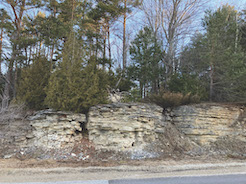Door County: Barely Filtered
- Share
- Tweet
- Pin
- Share

Geology makes county’s groundwater more vulnerable
Greg Coulthurst keeps a video on his phone to show just how susceptible Door County’s groundwater is to contamination.
Not far from his home southwest of Sturgeon Bay, there’s a large sinkhole as well as a couple of creeks and ditches where water vanishes into the bedrock. Two hours after a major rainstorm, the Conservationist for the Door County Soil and Water Conservation Department (SWCD) gained access to a private property not far from the intersection of county roads C and M, and shot his video.
Just after downpours, springwater shot loudly and rapidly out of a rock outcropping like two creeks rushes out of a cliff.
“We have studies that show that within a matter of a couple of hours of a rain, surface water can be coming out of a spring from over a mile away,” said Coulthurst.
Most of Door County, other than some acreage in Clay Banks, has far less soil over bedrock than most of the rest of Wisconsin. That’s because Door County has karst geology – a type of landscape where the dissolving of bedrock creates sinkholes, sinking streams, caves, springs and fractures that allow water to travel easily downward into the groundwater.
“As far as the soils go in our county, almost 22% of land has less than 18 inches; nearly 40% is either 36 inches or less,” Coulthurst said. “That’s our filter for anything on the surface until it gets into the bedrock. Once it gets into the bedrock, there’s very little filtration that takes place unless it’s filled with soil particles.”
The SWCD has studied how quickly surface water reaches the groundwater in several locations. At Dunes Lake, on private property near Shivering Sands north of Sturgeon Bay, the department found that water emptying out of four springs had taken two to four months to travel from the surface to the west and north into Dunes Lake.
That’s quite a bit longer, quite a bit more filtration and ample time for bacteria from the surface to die in the ground than the springs near the C and M sinkhole, Coulthurst said. Still, by standards elsewhere, it’s not slow for groundwater.
“If you compare it to other parts of the state, even sand-and-gravel aquifers, that two-to-three months is lightning-fast,” Coulthurst said.
Coulthurst said karst geology can be good and bad for groundwater. He said since the water moves quickly downward – either straight or in stair-step fashion within cracks and crevices – contaminants move through the system quickly.

“It’s a blessing and a curse,” he said. “Contaminants can get into our groundwater very fast. They can also exit very fast because of the groundwater flow that we have. If you make improvements, you can see it fairly quickly. Some parts of the state have decades-old contaminants that take a long time to flush through.”
Other parts of the state don’t rely upon private wells as Door County does – some 8,000 private wells are in use, and more than 580 abandoned wells exist, according to the records Coulthurst’s department tracks. So when contaminated water is moving fast through a system, it’s moving quickly to those wells.
Outbreak 2007 showed ‘We’re all connected’
Door County learned this back in 2007 when environmental investigators flocked to the peninsula for emergency fact-finding after a new, properly designed septic system failed at a new restaurant. The contaminated well water from that event sickened 229 people with acute gastroenteritis.
The problem, said Door County Sanitarian John Teichtler, was a crack and leak in a rubberized pipe-fitting.
In tests, dye poured down drains showed up in well water onsite and miles away within six to 15 days. The study demonstrated that “in highly vulnerable hydrogeological settings, compliance with regulations may not provide adequate protection from fecal pathogens,” according to the National Groundwater Association.
Former Door County Public Health Department Officer/Manager Sue Powers said health investigators found that “super-contagious” norovirus had spread due to an ill customer or employee. They contacted everyone who worked in the restaurant and ate there, as well as family members of employees.

“Because the septic system was leaking, it [norovirus] walked right over to the well,” Powers said.
When the dye showed up in drinking water as far as two or three miles away, property owners there expressed concern and outrage. Powers said there was no record of neighbors becoming ill from their well water, perhaps because they drank bottled water after hearing about the outbreak or due to the time it took for water from the septic leak to reach their wells.
Powers said people who relish privacy can build a home on a large wooded lot, but they’re still closely sharing groundwater with Door County properties next door, or even miles away.
“The big lesson for me was, we’re all connected, whether we want to be or not,” Powers said. “All of these incidents help us learn, unfortunately.”
The county always had protocols in place and further strengthened them after the 2007 outbreak, Powers said.



